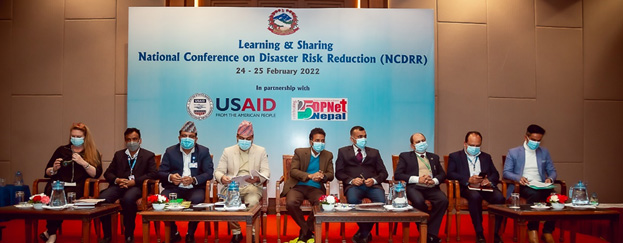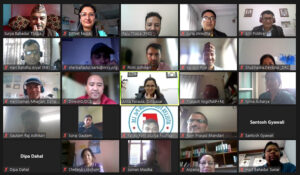
By Surya Bahadur Thapa, Chairperson, Disaster Preparedness Network (DPNet), Nepal

The colonisation of Southeast Asian countries by European powers like Britain, France, and Holland started in the 16th century and continued until the mid-20th century. Nepal, as an exception, was never colonised by any foreign power, which is a source of pride for the country’s sovereignty and its people. During the colonisation period, the entire South Asia was preoccupied with politics, resulting in the neglect of Disaster Risk Reduction (DRR) issues. In the postcolonial era South Asian countries including Nepal have been developing policies, plans and structures to reduce the risk of disasters, prioritise risk reduction and disaster management in their national priorities, and save the life and property of their citizens.
Nepal is a country of diverse topography and climatic conditions, with an area of 147,516 square kilometers. The Himalayas and the plain lands are part of its geography. Nepal is highly susceptible to various hazards because of its geographical position, varied topography, rugged mountains, and steep landscape. One-third of the world’s total 2,400 kilometers of the Himalayas lies in Nepal. The prevalence of natural hazards is due to the variation of altitude from 60 meters to 8,848.86 meters within a distance of fewer than 200 kilometers. The steep slopes and still growing Himalayan range, coupled with heavy monsoon rainfall, lead to geological and hydro-meteorological hazards, including landslides, debris flows, floods, and glacial lake outburst floods (GLOFs), epidemics, and droughts. Nepal is equally exposed to seismic activity resulting from the subduction of the Indian tectonic plate into the Eurasian (Tibetan) plate. In addition to geophysical and hydro-meteorological conditions, environmental degradation, climate change, socioeconomic conditions of the people, human development index, scattered settlements, unplanned rapid settlements, environmental pollution, inadequate coping abilities of communities, and challenges to mainstream DRR in development and its localisation further elevate the risk of disaster.
The Natural Calamity Relief Act, enforced in 1982, made Nepal the first country in South Asia to have a disaster-specific act. This relief act was mainly focused on post-disaster than pre-disaster action and preparation. With the growth of understanding of disaster risk reduction all over the globe and Nepal’s commitment to the International Decade of Natural Disaster Reduction , The National Action Plan for Disaster Management was introduced in 1996. Correspondingly in the same year (1996), individuals and organisations working in field of DRR in Nepal unites to form a platform called as Disaster Preparedness Network-Nepal (DPNet) which has been actively involved in disaster risk reduction
and management (DRR&M) for over 27 years. The disaster management component was included in the Local Self Governance Act, developed in 1999, based on the Action Plan. To support this DPNet developed the guideline and provided technical Support to 11 districts for the development of District Disaster Preparedness and Response Plan instead of Disaster Contingency Plan. The institutional framework for disaster risk management has been significantly strengthened since 2009 with the adoption of the National Strategy for Disaster Risk Management (NSDRM) in alignment with Nepal’s commitment to the Hyogo Framework for Action (HFA). Correspondingly in the same year (2007), to make it more action oriented, DPNet was officially registered in the District Administration Office in Kathmandu, and since then, it has fostered coordination, cooperation, and partnerships between national and international organisations, government bodies, and various stakeholders involved in disaster management and humanitarian assistance. DPNet took the lead in publishing the Nepal Disaster Report, which was later adopted and endorsed by the Government of Nepal. Additionally, DPNet also spearheaded the organisation of important discussions on topics such as monsoon preparedness and other current disaster-related issues requiring urgent humanitarian support. Nepal’s new federal structure and system of governance have provided opportunities to institutionalise a much more decentralised system of disaster risk management in Nepal. The Nepal Government (Work Division) Regulation, 2017, identified the roles and jurisdiction of all federal ministries, with MoHA identified as the ‘nodal ministry’ for coordinating disaster risk management activities throughout the country. The transition to federalism has provided an opportunity to prioritise stronger disaster risk management by all sectors at all levels. Disaster Risk Reduction and Management Act, 2017; Local Government Operational Act, 2017; Nepal Government (Work Division) Regulations, 2017; National Policy on Disaster Risk Reduction, 2018; Public Health Act, 2018; Disaster Risk Reduction National Strategic Plan of Action (2018-2030); Private Housing Rebuilding Grant for the Flood and Landslide Victims 2017; Public Housing Program Implementation Sample Guidelines, 2018; and Guidelines for the Relocation and Rehabilitation of High-Risk Settlements, 2018 were developed during this period. The DRRM Act was enacted in 2017, replacing the 1982 Natural Calamity (Relief) Act. DPNET has played a significant role in introducing the long-awaited Disaster Risk Reduction and Management Act and supported the whole process of Disaster Risk Reduction National Policy 2018 and Disaster Risk Reduction National Strategic Action Plan (2018-2030). The vision of having safe communities and a safer Nepal, and mission is to strengthen the disaster resilience of communities and institutions through coordinated and collaborative planning, community action, and policy advocacy is on the way to fulfillment by those legal frameworks.
DPNet-Nepal has been a driving force for DRR&M in Nepal since its establishment in 1996. Starting with 12 members, the organisation now has 126 institutional and life members including NGOs, INGOs and UN organisations dedicated to coordinating, collaborating, and sharing experiences to avoid duplication in emergency response. DPNet works closely with the Government of Nepal, civil society networks and federation. DPNet efforts have led to the formulation of DRR-related legal frameworks and other pertinent DRR works. The organisation has also actively participated in various national, SAARC level, and international forums to raise the voice on DRR&M in Nepal. As the SPHERE focal point for the country, DPNet-Nepal organised Sphere Training of Trainers (ToT) and published different Sphere Standards in the local language . DPNet play a role as the Secretariat of the National Platform for Disaster Risk Reduction (NPDRR), which is chaired by the Executive Chief of the National Disaster Risk Reduction and Management Authority (NDRRMA). DPNet has initiated an open and online platform, the Virtual DRR Platform, where individuals can participate and share their thoughts on disaster-related topics and discussions. Also, DPNet have created an Online Resource Center (ORC), a well-managed online hub or collection for scattered legal/research and any other documents related to disaster. For the solidarity and collective effort for DRR, DPNet is working in collaboration with National Disaster Management Network of Nepal (DiMaNN) and other disaster related networks at national level and affiliated with Global Network of Civil Society Organisations for Disaster Reduction (GNDR), Asian Disaster Reduction and Response Network (ADRRN) and South Asia Together for Humanitarian Imperative (SATHI) at regional and international level.
Disclaimer: The views expressed in this piece are those of the author/s and do not necessarily reflect the views or policies of AIDMI.